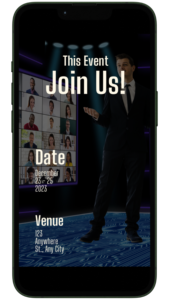Introduction
In the ever-evolving and dynamic world of virtual event planning, the role of Hobnob extends far beyond being just a platform for crafting and sending digital invitations. It emerges as an all-encompassing tool, designed to significantly enhance and streamline the entire virtual event experience. When you integrate Hobnob into your event planning process, you’re not just setting the stage for the success of your current event but are also laying down a robust foundation for a series of future virtual gatherings. This includes everything from interactive webinars and engaging online workshops to expansive, large-scale virtual conferences.
Hobnob’s versatility makes it an invaluable asset in the virtual event landscape. Its range of features caters to various aspects of event planning and management, making it an ideal choice for event organizers looking to create a seamless and dynamic virtual experience. By incorporating Hobnob, you can ensure a level of sophistication and efficiency in your event management process, which is crucial for the successful execution of any virtual event.
The platform’s comprehensive capabilities include but are not limited to efficient participant management, real-time communication tools, and interactive elements that can elevate the attendee experience. Whether you’re looking to organize a small webinar with focused discussions or a large virtual conference with multiple sessions, Hobnob provides the flexibility and functionality to meet diverse event requirements.
Moreover, the integration of Hobnob into your virtual event planning process can transform the way you connect with and engage your audience. Its intuitive design and user-friendly interface make it accessible to a wide range of users, ensuring that your attendees have a smooth and enjoyable experience from the moment they receive your digital invitation to the event’s conclusion.
As an event planner, the transition to virtual platforms presents both exciting opportunities and unique challenges. To orchestrate a successful virtual event, meticulous planning, adaptability, and the right technological tools are indispensable. This is where Hobnob, an innovative digital invitation app, comes into play as a powerful tool in your virtual event planning arsenal.
Hobnob is not just about sending digital invites; it’s a comprehensive solution that addresses various facets of virtual event planning. It seamlessly bridges the gap between traditional event planning and the digital world, offering features that cater to the modern attendee’s expectations. With Hobnob, you can manage guest lists, send out stylish, personalized invitations, and create an interactive environment for your attendees. It empowers you to chat with your guests, collect RSVPs efficiently, manage event-related photos, and send instant text updates, elevating the standard of your virtual event management.
But the journey of planning a successful virtual event goes beyond choosing the right app. It involves understanding the nuances of virtual event platforms, engaging with the target audience effectively, and utilizing event technology to its fullest. As we delve deeper, we’ll explore how to integrate tools like Hobnob into your overall event strategy, ensuring that every aspect of your virtual event, from initial planning to final execution, resonates with your audience and achieves your event goals.
Embracing the change, today’s event planners and organizers must navigate through a plethora of aspects such as audience engagement, event marketing, live event management, and much more. This introduction serves as a gateway to unlocking the potential of virtual events and leveraging digital tools like Hobnob to create memorable, impactful online experiences. Let’s embark on this journey to master the art of virtual event planning, transforming challenges into opportunities for innovation and success.

Understanding Virtual Event Planning
Virtual event planning, a rapidly evolving facet of the broader event management industry, demands a harmonious blend of strategic planning and technological expertise to orchestrate a successful event. This paradigm shift towards online platforms has ushered in an era where virtual event planners must embrace a novel perspective, one that prioritizes elements intrinsic to the digital sphere. These elements encompass not just the basics of virtual event technology and attendee engagement but also the nuances of proficient online event management.
At the core of this transition is the recognition that virtual events, whether they are webinars, virtual conferences, or online workshops, require a different approach than traditional, physical events. The absence of a physical venue brings to the fore aspects such as virtual event platforms, which become the stage upon which the event unfolds. These platforms need to be chosen with care, ensuring they provide the necessary tools for effective communication, presentation, and interaction.
The role of the virtual event planner has thus expanded. It now includes being an adept technologist, capable of leveraging event technology to create an immersive and interactive experience. This technology ranges from simple webinar tools to sophisticated software enabling virtual networking opportunities, interactive breakout sessions, and engaging virtual booths. The planner must ensure that these technologies are not only functional but also user-friendly, catering to the diverse technological proficiencies of the attendees.
Engagement in the virtual realm takes on a new meaning. Attendee engagement now relies heavily on the creative use of digital tools. Techniques to foster this engagement include gamification, live polling, and interactive Q&A sessions. The goal is to transform passive viewers into active participants, making them feel as much a part of the virtual event as they would in a physical one.
Efficient online event management is another critical aspect. It involves meticulous planning and execution, from the initial stages of setting event goals and identifying the target audience to the final steps of post-event analysis and feedback collection. This process is supported by various online tools and software that aid in tasks such as attendee registration, schedule management, and real-time analytics.
Moreover, the virtual event planner must be cognizant of the challenges and limitations inherent in online events, such as the potential for technical difficulties and the need for strong internet connectivity. They must also be skilled in digital marketing, using platforms like social media and email campaigns to promote the event and attract a wider audience.
Defining Your Event Goals: Essential to the foundation of any virtual event, be it a virtual meeting, a networking event, or a comprehensive virtual conference, is the clarity of purpose. Your objectives could range from educational, networking, to sales-oriented goals. These goals are instrumental in shaping your event plan, influencing everything from content to the choice of technology and the method of attendee interaction. This clarity also helps in creating a targeted virtual event planning checklist that guides the entire process.
Understanding Your Target Audience: A deep understanding of your audience is crucial. This involves not just knowing their demographics but also their digital behavior, preferences, and expectations from a virtual event. This insight ensures that the event resonates with them, resulting in higher engagement and a successful virtual event.
Choosing the Right Virtual Event Platform: In the realm of virtual event planning, the selection of a platform is critical. A multifaceted platform like Hobnob stands out, offering features that streamline event management. These include chatting with guests, managing RSVPs, and sharing instant updates, ensuring seamless virtual attendee interaction and engagement.
Innovative Engagement Strategies: To maintain audience interest and participation, integrating interactive elements is key. This could involve Q&A sessions, breakout rooms, virtual booths, and even interactive polls or quizzes. Tools like Hobnob can significantly enhance this interaction with its user-friendly chat and photo-sharing features, fostering a sense of community and connection among attendees.
Maximizing Social Media and Event Marketing: The power of social media platforms like Facebook Live in promoting and enhancing engagement at your virtual event cannot be overstated. Leveraging these platforms for event marketing can exponentially increase your event’s visibility and reach, attracting potential attendees and amplifying event success.
Creating Networking Opportunities: Despite being online, virtual events can and should facilitate networking opportunities. By organizing structured breakout sessions or informal networking events, you allow attendees to connect, share ideas, and form professional relationships, just as they would in a physical event.
Prioritizing Feedback and Follow-Up: Gathering post-event feedback is integral to gauging the success of your event and guiding the planning of future events. This feedback, collected through surveys, social media interactions, or direct communication, offers valuable insights into attendee satisfaction and areas for improvement.
Integrating Hobnob in Your Virtual Event Planning

In the dynamic world of virtual event planning, Hobnob stands out as more than a platform for sending digital invitations. It’s a comprehensive tool that significantly enhances and streamlines the entire virtual event experience. Integrating Hobnob into your planning process ensures the success of your current event and lays a solid foundation for future virtual gatherings, whether they are webinars, online workshops, or large-scale virtual conferences.
Efficient Organization: Hobnob excels in making the organization of virtual events effortless. Event organizers and planners will find its group management features particularly beneficial. It simplifies the creation and management of guest lists, making it easier to stay in touch, send updates, and organize sub-groups for various event segments, like breakout sessions or interest-specific forums. This level of organization is crucial for both pre-event planning and post-event follow-ups, ensuring a smooth and successful virtual event.
Real-Time Communication: Timely communication is crucial in the fast-paced environment of a virtual event. Hobnob enables instant text updates and live chat capabilities during the event, enhancing virtual attendee engagement. This feature is invaluable for providing live event updates, making spontaneous announcements, or efficiently managing interactive segments like Q&A sessions. It ensures that every attendee feels connected and engaged, contributing to the overall success of the virtual gathering.
Photo Management: A unique aspect of Hobnob is its photo management feature, allowing attendees to share and manage photos from the event. This not only adds a personal touch but also encourages interactive participation. It’s an excellent tool for capturing and sharing memories, fostering a sense of community among participants. Post-event, these shared photos can further enhance attendee engagement, strengthening the connections made during the event.
RSVP Collection: Measuring the impact and reach of your virtual event is critical, and Hobnob’s real-time RSVP management system is designed to do just that. This feature provides insights into attendee numbers and engagement levels, offering valuable data for evaluating the effectiveness of your event marketing strategies and understanding attendee behavior. This information is essential for refining your approach to future virtual events.
Seamless Integration with Marketing Efforts: Hobnob also serves as a potent tool in your event marketing toolkit. Its capabilities extend to supporting email marketing campaigns, integrating with social media platforms for broader reach, and even facilitating event promotion via its digital invitation system. This seamless integration ensures that your marketing efforts are not only cohesive but also effectively targeted to your desired audience, increasing the likelihood of a successful virtual event.
Checklist for a Successful Virtual Event
Organizing a successful virtual event is akin to conducting a symphony – it requires meticulous planning, precise execution, and an attentive eye to detail. This comprehensive checklist is designed to guide you through the essential components and additional considerations necessary to ensure your event not only meets but goes beyond expectations.
Defining Event Goals and Audience: Start by clearly articulating your objectives. What do you hope to achieve with your event? Are you focusing on education, boosting sales, or fostering networking opportunities? Equally critical is a deep understanding of your audience. Who are they? What are their interests, needs, and online behaviors? This knowledge is key to customizing your event, ensuring it aligns perfectly with attendee expectations, thereby boosting engagement and participation.
Choosing the Right Virtual Event Platform: The platform you select can make a significant difference. It needs to fit your event’s unique requirements. Look for a platform that is not only versatile and user-friendly but also supports essential functionalities. A platform like Hobnob, which offers robust virtual event technology, tools for engaging attendees, and comprehensive event management software, can align seamlessly with your event goals and the preferences of your audience.
Planning Content and Schedule: Your event’s content is its backbone. This includes keynote speeches, breakout sessions, and interactive activities. Ensure these elements align with your event’s objectives. When scheduling, consider the best ways to maximize engagement – this might mean interspersing high-energy sessions with more informative talks. Embrace a variety of formats like webinars, live streams, or virtual conferences to suit different learning styles and participant preferences.
Promoting the Event: Utilize the full spectrum of digital marketing to get the word out. Social media platforms can create buzz, while email marketing can provide personalized invitations and reminders. Don’t forget the power of platforms like Facebook Live for pre-event promotion. A well-rounded marketing strategy can significantly expand your reach and attract a larger audience.
Interactive Elements for Engagement: To keep your audience captivated, include interactive features such as Q&A sessions, live polls, virtual exhibition booths, and breakout rooms for smaller group discussions. These elements not only keep the audience engaged but also contribute to a dynamic and memorable event.
Facilitating Networking Opportunities: Networking is often a key goal for attendees. Create spaces within your virtual platform for networking events, discussion sessions, or casual meet-ups. These can replicate the networking experience of in-person events, adding immense value to your virtual event.
Smooth Execution with Event Technology: Deploy state-of-the-art technology for a flawless event. This includes reliable streaming services, interactive engagement tools, and effective event management software. Ensuring smooth technological performance is crucial to maintain high levels of engagement and to deliver a positive experience to your attendees.
Collecting Feedback for Future Improvements: Gathering feedback post-event is essential. It provides insights into the event’s success and areas needing improvement. Use surveys, monitor social media interactions, and encourage direct feedback. This information is critical for refining your approach in future events.
Monitoring and Analyzing Engagement: Keep track of how engaged your audience is throughout the event. Use the analytics tools provided by your virtual event platform to understand what aspects are working and which aren’t. This real-time data allows for immediate adjustments and helps in shaping future event strategies.
Ensuring Accessibility and Inclusivity: Your event should be accessible to everyone. Consider adding language options, closed captions for those who are hearing impaired, and ensuring the platform’s interface is navigable for attendees with different abilities.
Preparing a Contingency Plan: Always be ready for unexpected technical glitches. A solid contingency plan, including backup streaming options or alternative communication methods, is essential to ensure your event continues smoothly in the face of challenges.
Post-Event Engagement: Keep the momentum going even after the event concludes. Follow up with attendees via email, share highlights, or provide access to recorded content. This not only enhances their overall experience but also helps in building a lasting relationship with your audience, setting the stage for future events.
By meticulously following this checklist, you’re not just organizing an event; you’re creating an experience that resonates with attendees and achieves your goals, setting a high standard for future virtual events.
Conclusion
The journey of planning for virtual events is a dynamic, multifaceted, and ultimately rewarding process. As an event planner or organizer venturing into the realm of virtual event planning, you’re embarking on a path filled with opportunities for engagement, innovation, and expansion. With the right approach, coupled with versatile tools like Hobnob, your event can transcend the traditional boundaries of event planning, offering a unique and memorable experience.
Virtual events, ranging from online webinars to extensive virtual conferences, have opened new horizons in the event planning industry. They allow for broader audience reach, overcoming the geographical limitations of physical events. This global accessibility is one of the many advantages of a virtual event platform. It is imperative to leverage this to ensure that your event resonates with a diverse audience, fulfilling your event goals and fostering greater attendee engagement.
As you delve into virtual event planning, remember to incorporate key elements such as effective event management, utilizing social media platforms like Facebook Live for promotion, and embracing event marketing strategies to amplify your event’s visibility. The integration of event technology, from live streaming services to event management software, is essential in creating a seamless and interactive experience for your attendees.
Consider the importance of a hybrid event that combines physical and virtual elements, offering a comprehensive experience to your attendees, whether they are present in-person or online. This approach broadens your event’s appeal and accessibility, making it a successful event by all measures.
Engagement strategies like Q&A sessions, breakout room, and virtual booth are crucial in maintaining high levels of attendee engagement. These interactive elements, along with opportunities for networking in breakout rooms, whether in a virtual meeting or a networking event, enrich the attendee experience, making your event not just an occasion, but a memorable journey.
As a virtual event planner, you must also focus on understanding your target audience, tailoring your event to meet their specific needs and preferences. This audience-centric approach, combined with ongoing event promotion and engagement strategies, ensures that your event attracts and retains the interest of potential attendees.
Event sponsorship, a vital aspect of event planning, can also be adapted to the virtual format. Offering sponsors a virtual booth or a speaking slot can provide them with valuable exposure while adding to the event’s content. Similarly, selecting the right speaker for your virtual event can significantly influence its success, engaging and inspiring your audience.
Remember to collect feedback post-event, as this is crucial for measuring event success and planning for future events. Use this feedback to refine your virtual event planning checklist, ensuring continuous improvement in your approach to virtual events.
In summary, the landscape of virtual events is ever-evolving, filled with opportunities for innovation and growth. By leveraging tools like Hobnob, staying abreast of the latest in virtual event technology, and maintaining a keen focus on attendee engagement and experience, you can ensure the success of your virtual events. Keep these strategies in mind as you plan and execute your events, and look forward to creating experiences that are not only successful but also pave the way for the future of event planning. Happy planning, and here’s to the success of your next virtual event!






















